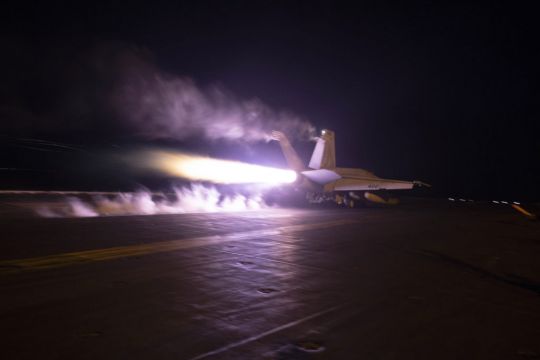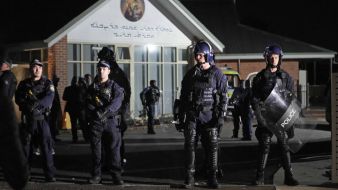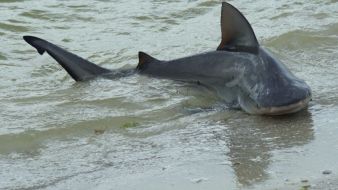The United States and Britain struck 36 Houthi targets in Yemen on Saturday in a second wave of assaults meant to further disable Iran-backed groups that have relentlessly attacked American and international interests in the wake of the Israel-Hamas war.
But Washington once more did not directly target Iran as it tries to find a balance between a forceful response and intensifying the conflict.
US Central Command said its forces conducted an additional strike on Sunday “in self-defence against a Houthi anti-ship cruise missile prepared to launch against ships in the Red Sea”.
A post on X said: “US forces identified the cruise missile in Houthi-controlled areas of Yemen and determined it presented an imminent threat to US navy ships and merchant vessels in the region.
“This action will protect freedom of navigation and make international waters safer and more secure for US navy vessels and merchant vessels.”

The strikes on Saturday against the Houthis were launched by US warships and American and British fighter jets. The strikes followed an air assault in Iraq and Syria on Friday that targeted other Iranian-backed militias and the Iranian Revolutionary Guard in retaliation for the drone strike that killed three US troops in Jordan last weekend.
The Houthi targets on Saturday were in 13 different locations and were struck by US F/A-18 fighter jets from the USS Dwight D Eisenhower aircraft carrier, by British Typhoon FGR4 fighter aircraft and by the US navy destroyers USS Gravely and the USS Carney firing Tomahawk missiles from the Red Sea, according to US officials and the Ministry of Defence.
The US warned its response after the soldiers’ deaths at the Tower 22 base in Jordan last Sunday would not be limited to one night, one target or one group. While there has been no suggestion the Houthis were directly responsible, they have been one of the prime US adversaries since Hamas attacked Israel on October 7, killing more than 1,200 people and taking about 250 hostages.
The Health Ministry in Hamas-ruled Gaza said more than 26,000 people have been killed and more than 64,400 wounded in the Israeli military operation since the war began.
The Houthis have been conducting almost daily missile or drone attacks against commercial and military ships transiting the Red Sea and Gulf of Aden and they have made clear they have no intention of scaling back their campaign despite pressure from the American and British campaign.
Mohammed al-Bukhaiti, a Houthi official, said “military operations against Israel will continue until the crimes of genocide in Gaza are stopped and the siege on its residents is lifted, no matter the sacrifices it costs us”.
He wrote online that the “American-British aggression against Yemen will not go unanswered, and we will meet escalation with escalation”.
The Biden administration has indicated the latest strikes are unlikely to be the last. The US has blamed the Jordan attack on the Islamic Resistance in Iraq, a coalition of Iranian-backed militias. Iran has tried to distance itself from the drone strike, saying the militias act independently of its direction.
US Defence Secretary Lloyd Austin said in a statement that the military action, with support from Australia, Bahrain, Canada, Denmark, the Netherlands, and New Zealand, “sends a clear message to the Houthis that they will continue to bear further consequences if they do not end their illegal attacks on international shipping and naval vessels”.
He added: “We will not hesitate to defend lives and the free flow of commerce in one of the world’s most critical waterways.”
The US Defence Department said the strikes targeted sites associated with the Houthis’ deeply buried weapons storage facilities, missile systems and launchers, air defence systems, radars and helicopters.
The British military said it struck a ground control station west of Yemen’s capital, Sanaa, that has been used to control Houthi drones that have launched against vessels in the Red Sea.
US President Joe Biden was briefed on the strikes before he left Delaware on Saturday for an election campaign trip, according to an administration official.
The latest strikes marked the third time the US and Britain had conducted a large joint operation to strike Houthi weapon launchers, radar sites and drones. The strikes in Yemen are meant to underscore the broader message to Iran that Washington holds Tehran responsible for arming, funding and training the array of militias – from Hezbollah in Lebanon, Hamas in Gaza, the Islamic Resistance in Iraq and the Houthis in Yemen – who are behind attacks across the Middle East against US and international interests.
Video shared online by people in Sanaa included the sound of explosions and at least one blast was seen lighting up the night sky. Residents described the blasts as happening around buildings associated with the Yemeni presidential compound.
The Houthi-controlled state-run news agency, SABA, reported strikes in al-Bayda, Dhamar, Hajjah, Hodeida, Taiz and Sanaa provinces.







